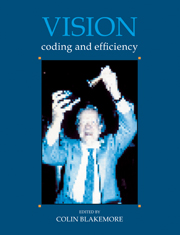Book contents
- Frontmatter
- Contents
- List of Contributors
- Preface
- Reply
- Acknowledgements
- Concepts of coding and efficiency
- Efficiency of the visual pathway
- Colour
- Brightness, adaptation and contrast
- Development of vision
- 19 On reformation of visual projection: cellular and molecular aspects
- 20 Retinal pathways and the developmental basis of binocular vision
- 21 Development of visual callosal connections
- 22 Sensitive periods in visual development: insights gained from studies of recovery of visual function in cats following early monocular deprivation or cortical lesions
- 23 The developmental course of cortical processing streams in the human infant
- 24 Maturation of mechanisms for efficient spatial vision
- 25 The puzzle of amblyopia
- Depth and texture
- Motion
- From image to object
- Index
20 - Retinal pathways and the developmental basis of binocular vision
Published online by Cambridge University Press: 05 May 2010
- Frontmatter
- Contents
- List of Contributors
- Preface
- Reply
- Acknowledgements
- Concepts of coding and efficiency
- Efficiency of the visual pathway
- Colour
- Brightness, adaptation and contrast
- Development of vision
- 19 On reformation of visual projection: cellular and molecular aspects
- 20 Retinal pathways and the developmental basis of binocular vision
- 21 Development of visual callosal connections
- 22 Sensitive periods in visual development: insights gained from studies of recovery of visual function in cats following early monocular deprivation or cortical lesions
- 23 The developmental course of cortical processing streams in the human infant
- 24 Maturation of mechanisms for efficient spatial vision
- 25 The puzzle of amblyopia
- Depth and texture
- Motion
- From image to object
- Index
Summary
The study of binocular mechanisms in visual cortex is just one of the many areas of vision influenced by Horace Barlow. How do cortical neurons utilise positional disparities to signal depth (Barlow, Blakemore & Pettigrew, 1967) and what developmental processes regulate the binocularity of cortical neurons (e.g. Barlow, 1975)? Although cortex is the first site in the geniculo-striate pathway in which binocular neurons are found, the fundamental basis of binocular vision is established much earlier in the visual pathway. It is the existence of bilateral retinal projections that ensures one point in visual space projects to one locus in the brain and so achieves the binocular congruence that is exploited by cortical neurons.
The binocular representation of each visual hemifield on the opposite side of the brain depends on the partial decussation of the retinal projections. For visual congruence, not only must the retinal decussation line coincide with the representation of the vertical meridian of the visual field but also the mapping rules of the resulting crossed and uncrossed projections must differ (Thompson, 1979, 1984). As Sperry (1963) recognised, there has to be bilateral symmetry in the representation of the nasotemporal retinal axis and a developmental mechanism that ensures retinal ganglion cells from two different retinal regions, one nasal and one temporal, terminate in a common locus in the target nucleus. These rather stringent conditions for adult retinal projections are not fulfilled in the developing animal. In this chapter, I shall describe the features of retinal projections that permit binocular mappings, the development of some of these features and how they can be influenced by early experimental manipulations.
- Type
- Chapter
- Information
- VisionCoding and Efficiency, pp. 209 - 223Publisher: Cambridge University PressPrint publication year: 1991
- 2
- Cited by



